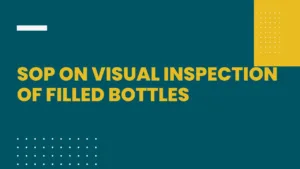SOP on Visual Inspection of Filled Bottles (Oral Liquids)

SOP on Visual Inspection of Filled Bottles
FAQs for Visual Inspection of Filled Bottles SOP
Q1: Why is visual inspection of filled bottles important? A: Visual inspection ensures the quality and integrity of filled bottles, helping to identify and address defects or anomalies that may affect product safety and customer satisfaction.
Q2: What are the key aspects covered in the Visual Inspection of Filled Bottles process? A: The process covers verification of batch details, appearance and labeling, fill level inspection, seal integrity, checking for foreign particles, and cap inspection.
Q3: How should I prepare for Visual Inspection of Filled Bottles? A: Ensure the inspection area is clean and well-lit. Verify that all necessary equipment, such as magnifying glass and inspection table, is in good working condition.
Q4: What should I look for during appearance and labeling inspection? A: Inspect for visible defects such as cracks or scratches. Verify the accuracy and placement of labels to ensure they adhere to approved specifications.
Q5: What actions should be taken if a defect is found during inspection? A: Document the defect, report findings to the relevant department, and initiate corrective actions. Rejected bottles should be clearly marked, segregated, and properly disposed of.
Q6: Is training required for personnel conducting Visual Inspection of Filled Bottles? A: Yes, personnel involved in visual inspection should be adequately trained and certified for the task. Regular reviews and updates to training programs are essential.
Q7: How often should the SOP be reviewed and updated? A: The SOP should be regularly reviewed, and updates should be made as needed to reflect changes in procedures, equipment, or regulations.
Q8: What records need to be maintained for Visual Inspection of Filled Bottles? A: Detailed records, including batch details, inspection findings, and any corrective actions taken, should be maintained for effective documentation.
Q9: Can a bottle with an underfilled or overfilled content be accepted? A: No, bottles with underfilled or overfilled contents should be discarded during the inspection process to maintain product quality and consistency.
Q10: How can I obtain a copy of the SOP? A: Copies of the SOP can be obtained from the designated personnel responsible for document distribution within the company.
Also, Visit:
B. Pharma Notes | B. Pharma Notes | Study material Bachelor of Pharmacy pdf